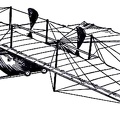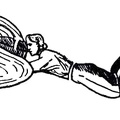One of the first to work upon Sir George Cayley’s theories was an experimenter
named Henson. He planned an ambitious machine weighing about a ton. It was to have planes of canvas stretched over a rigidly trussed frame of bamboo rods and hollow wooden spars; and these planes were to contain 4500 square feet of lifting surface, and be driven by screws operated by a steam engine of 30 h.p.
But this craft did not take practical shape, although in its appearance and many of its details it bore a resemblance to machines which ultimately were to fly. In the specification of the patent he took out for his invention, Henson indicated that it was for
“Improvements in locomotive apparatus and machinery for conveying letters, goods, and passengers from place to place through the air.”
- Author
- The Project Gutenberg eBook, The Aeroplane, by Claude Grahame-White and Harry Harper
Published 1914 - Posted on
- Thursday 7 May 2020
- Dimensions
- 900*371
- Tags
- Albums
- Technology / Transport / Air
- Visits
- 575
- Downloads
- 22
 Download Photo
Download Photo





